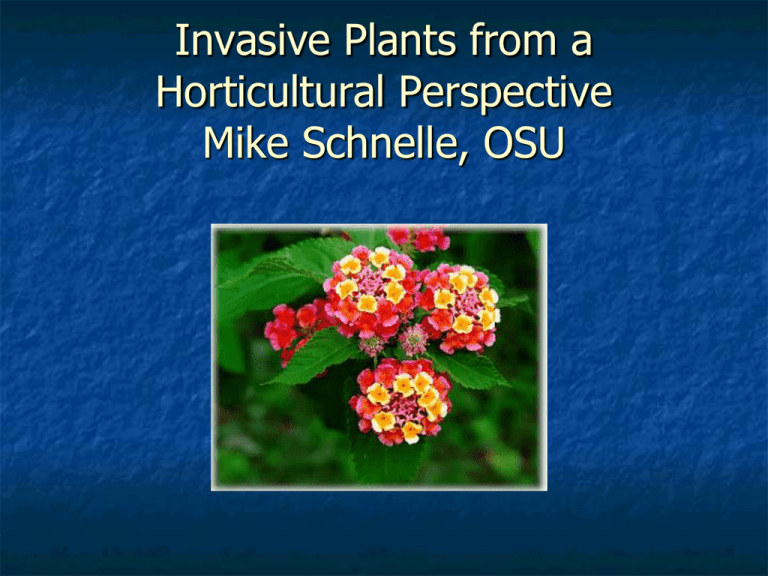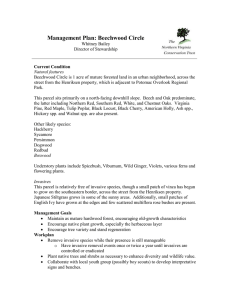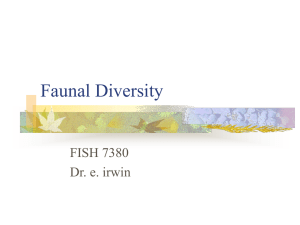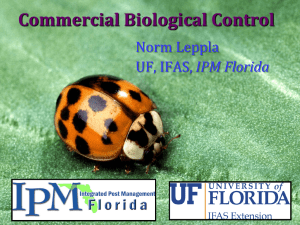Origins of Plant Materials Both native and non
advertisement

Invasive Plants from a Horticultural Perspective Mike Schnelle, OSU Please speak up as you have thoughts/questions during presentation Origins of Plant Materials Both native and non-native plants have value in the garden and landscape Both native and non-native plants have pest resistance, not just natives Both will be discussed today Start With Native Plants Growers and consumers could spend a lifetime just working with plants from the Lower 48. However, many ornamental characteristics and “looks” cannot be satisfied by our natives alone. So when aesthetics and ornamental attributes are factored in, it is hard to overlook plants from other countries. Mexican Plum (Prunus mexicana) 12-15’ tree native to Mexico and much of U.S. including Kansas Grow for spring white flowers and sheer toughness of the tree Heavy, wet soils will send this species into a mortality spiral – OKC Bombing Memorial Some yellow fall color, attractive summer fruits Seed propagation Mexican Plum (Prunus mexicana) Prunus mexicana Despite the name, Mexican plum IS native to many southern and central U.S. states Serviceberry (Amelanchier) Greatly underutilized group of plants for Oklahoma and Southern locations Better known and used north of us White flowers in spring Pest-free summer foliage Yellow-orange-red fall color Showy edible fruits range from red-purple-black Growth habit varies from shrub to tree Many native to U.S. A crabapple alternative Serviceberry (Amelanchier) Non- native plants Appropriate when researched and used responsibly Pest advantage? Traits not found in U.S. Unsupervised Reproduction Happens with natives or exotics Arguments Against Non-Natives May not serve as host plants for pollinators May not be a significant food source for native fauna May reproduce without human intervention Other Invasive Plants A cultivated plant that under certain conditions will reproduce, unassisted by people, and ultimately displace native flora and occasionally native fauna No longer should we consider only exotic or introduced plants to be the only candidates. Natives in some instances could be invasive when moved out of their original U.S. range., Eastern redcedar for example. Challenges Most horticulturists want to continue to have the right to RESPONSIBLY introduce and grow plants of origins outside the U.S. Invasive plants are a hot topic among diverse professionals. Horticulturists have different training backgrounds and “ornamental motives” than do ecologists for example. Communication and rational discussion amongst various disciplines is paramount in coming to agreements that all can live with. Widespread Condemnation of Plants Because of the sheer size of the U.S., it is not logical nor appropriate to condemn any one species for cultivation anywhere in the continental U.S. It is questionable whether any species exists that would prove problematic in all 48/49 states (Hawaii is the exception). Ornamentals that Bear Fruit Strong movement underway to discourage many female or otherwise fruiting plants in the landscape The notion that a fruit-bearing plant will automatically be weedy IS NOT accurate Plants have to be screened/observed on an individual basis to determine their propensity to reproduce rampantly outside their intended area. Tamarix Pyrus Ligustrum sinense ‘Wimbei’ (Chinese dwarf privet) This cultivar (also found as ‘Wimbish’) has been around for quite some time. However, it has taken me years to realize its value in the landscape! Its diminutive size (4-7’), short internodes, variability from plant to plant really make for an exciting shrub, or extremely small “tree” in the landscape. Chinese dwarf privet Mimosa Lantana In the lower 48, this species is normally harmless to the environment. Most breeders are working on fruitless types more for the reason of toxicity than for weediness However, if we lived in Hawaii, for example, lantana could be a major issue Breeding for Sterility Breeding for sterility, non-fruiting plant, should be encouraged however when flowers are the primary focus and the resulting fruits are known to be problematic. Buddleia, for example, is currently being worked with to develop sterile new selections Euonymus alata Has reseeded in Eastern forest Remains essentially innocuous to our environment here in Oklahoma Ironwood (Parrotia persica) Parrotia persica One of many exciting plants, from the Middle East, that so far are not proving to be invasive! What About Our Native Plants? Eastern redcedar and others are beyond the scope of today’s presentation. However, some experts have issues with this indigenous conifer and others. Osage orange, hackberry and other natives are now being watched largely because setting fires has been discouraged Commonly Grown Oklahoma Ornamentals That are Being Scrutinized Sawtooth oak (Quercus acutisiima) Russian olive (Elaeagnus angustifolia) Autumn olive (Elaeagnus umbellata) Privet (Ligustrum ssp.) – all of them! Japanese barberry (Berberis thunbergii) Japanese spirea (Spiraea japonica) Chinese/Japanese wisteria (W. sinensis/floribunda) Asian bittersweet (Celastrus orbiculatus) Wintercreeper (Euonymus fortunei)_ Barberry a Problem in New England Again, most fruiting non-natives in OK are not problematic More “Bad” Plants Periwinkle (Vinca minor) Porcelain berry (Ampelopsis brevipedunculata) Japanese akebia (Akebia) Ajuga (Ajuga reptans) Saltcedar (Tamarix spp.) Beach vitex (Vitex rotundifolia) Many more as well as grasses and aquatics not discussed today! Possible Solutions Horticulturists must implement screening processes before introducing new plants to the market. This would demonstrate our concern for the environment and in some cases squelch a small no. of plants from ever becoming widespread. There may come a time when growers may want to consider voluntary stop sales on a few species. This has already transpired on the West Coast. For example, some people are no longer growing/selling Hedera helix (English ivy). Proposed Code of Ethics Do no harm to plant diversity and natural areas Perform risk assessments for introductions Remove invasives from plant collections Control invasives in natural areas Develop noninvasive and native alternative plant material Do not distribute plants and seeds that will be invasive elsewhere Educate the public Become partners with conservation organizations Drought/Heat/Cold Up until about two years ago, many of us considered a number of our “staple” landscape plants to be essentially bulletproof. However, given extreme drought, few record-cold nights and also record heat, some of these “bullet’proof” plants did indeed succumb or were badly damaged beyond aesthetically acceptable levels. Many of the best survivors are exotics! Native vs. Exotic It is interesting to note that many of our affected plants were/are native to the U.S. and often including the State of Oklahoma. Still, even with their native origins we have all been reminded that all living organisms have limits to what they can survive! One of the Few Unscathed Species from 2011-2012 Vitex (Vitex spp.) Genus as a whole taken for granted White, pink, purple or blue flowers on long spikes (for most spp.) Marijuana-like foliage Can grow to be a tree sometimes to 20’ Normally winters will take it back down Vitex Aralia elata ‘Variegata’ Variegated aralia Has been scorned by most because it is coarse and considered too overwhelming with it’s color patterns Should be used more – see Lendonwood Gardens or Sunshine Nursery for specimens to view Aralia spinosa (Devil’s walkingstick/Hercules club) Native Aralia sometimes goes unnoticed Large shrub – often a small tree to 20’+ Tropical looking leaves, white creamy flowers, club-like stems great for winter interest, purple black fruits Not a plant for the timid I’ve grown weary of people rejecting this genus solely based on the presence of thorns Staghorn sumac (Rhus typhina) Tiger Eyes sumac Rhus typhina Tiger Eyes Don’t Lose Sight of Sheer Size of U.S. Put Popular Articles Into Perspective Prioritizing Invasives Work could be done between ornamentals industry and OkIPC to rank “biggest” offenders in order to have a realistic starting point. Plants of Concern Ornamental pears (Pyrus spp.) Privet (Ligustrum spp.) Honeysuckle (Lonicera spp.) Tamarix (Tamarix spp.) Russian olive (Elaeagnus angustifolia) Other Species of Less Concern Paper mulberry (Broussenetia papyrifera) Mimosa (Albizia julibrissin) Common mullein (Verbascum spp.) Siberian elm (Ulmus pumila) Other Planned “Talks” are Underway for 2013 I am hopeful that a representative of OkIPC will come to an ONLA board meeting yet this year to begin a dialogue. Summary 1) All of us desire the same end result in leaving the land as good or better than what we inherited. However, our approaches to doing so will differ. 2) Many horticulturists will always desire to grow non-native plant materials in a responsible fashion of course. Summary (continued) 3) Plantspeople must continue to educate themselves about alternative plant materials, when warranted, that are safer to the environment, i.e. male selections, triploids, etc. 4) Solving or at least mitigating the invasives dilemma will necessitate a multidisciplinary approach meaning that horticulturists, ecologists, botanists, etc. come to the table and begin discussions Summary (continued) 5) “Talks” will occur yet this year between OkIPC and the Oklahoma Nursery and Landscape Association (ONLA). This is a step in the right direction. 6) In the end, concessions and compromise will be required from all parties involved. Thanks for Your Attention Questions?











